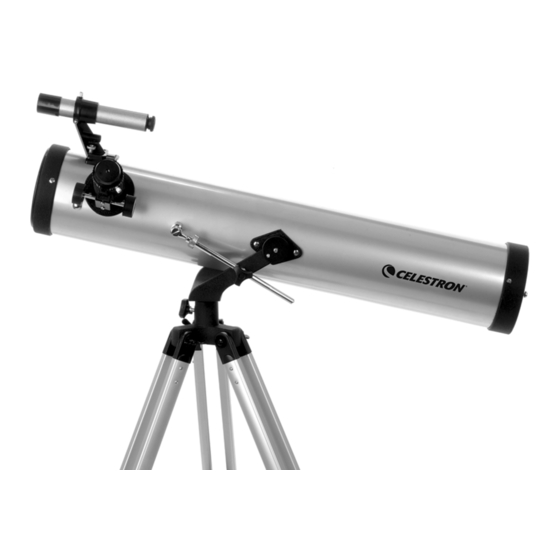Subscribe to Our Youtube Channel
Summary of Contents for Celestron 76
- Page 1 #21044...
- Page 2 I N T R O D U C T I O N Congratulations on your purchase and welcome to the Celestron world of amateur astronomy. Some of the terms and parts described in these instructions may be new to you, so a few commonly used terms you’ll want to be familiar with are defined below.
- Page 4 Unpack and lay out all of the parts in a large, clear area where you’ll have room to work. Keeping track of the parts, use the list below and the telescope diagram to confirm you have, and can identify each part.
- Page 5 Loosen the altitude slow motion rod locking screw (7) and the azimuth lock (11) on the base of altazimuth mount, then move the telescope in the desired direction. Look through the finderscope and pan the telescope until the object appears in the field of view. Once it’s in the field, tighten the altitude and azimuth locks.
-
Page 6: Telescope Maintenance
Important! Magnification through any telescope has its limits. These limits are determined by the laws of optics and the nature of the human eye. Most of your viewing will be done in the range of 35x to 120x. Higher powers are used mainly for lunar and sometimes planetary observing where you can greatly enlarge the image and the atmospheric conditions are near perfect. -
Page 7: Specifications
If your telescope is out of collimation, the best way to re-collimate it is with a good collimation tool. Celestron offers a Newtonian Collimation Tool (#94183) with detailed instructions that make it an easy chore. - Page 8 Celestron offers a full line of optional accessories for your telescope. Please refer to the Celestron Accessory Catalog (#93685) for a complete description, or logon to our web site at www.celestron.com. Eyepieces – An assortment of 1¼” eyepieces are available to give you a wide range of magnifications.
-
Page 9: Celestron Two Year Warranty
Celestron shall use reasonable efforts to repair or replace any telescope covered by this warranty within thirty days of receipt. In the event repair or replacement shall require more than thirty days, Celestron shall notify the customer accordingly. Celestron reserves the right to replace any product which has been discontinued from its product line with a new product of comparable value and function.

















Need help?
Do you have a question about the 76 and is the answer not in the manual?
Questions and answers
Why cant I see through my telescope
There are several possible reasons why you cannot see through your Celestron 76 telescope:
1. Assembly Issues – Ensure the telescope is correctly assembled by following the provided instructions.
2. Lens Covers – Remove any lens or dust covers that may still be in place.
3. Alignment – The optical system may need collimation (alignment), though it is factory-set.
4. Dirty Optics – Dust or fingerprints on the lenses can obstruct the view. Clean them using an optical cleaning kit.
5. Eyepiece or Barlow Lens Issues – Ensure the eyepiece and any additional lenses (such as a Barlow lens) are properly inserted.
6. Focus Adjustment – Adjust the focus knob to bring objects into sharp view.
7. Lighting Conditions – Try observing under proper lighting conditions and ensure you are pointing at a visible object.
8. Sun Viewing Precautions – Never point the telescope at the Sun without a proper solar filter to avoid damage.
If the problem persists, professional servicing may be required.
This answer is automatically generated